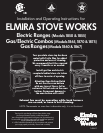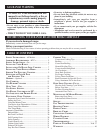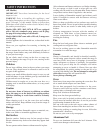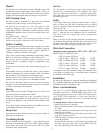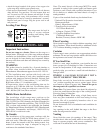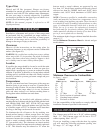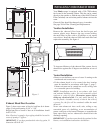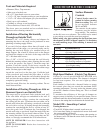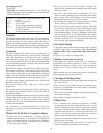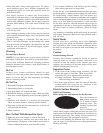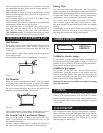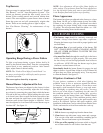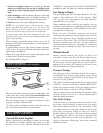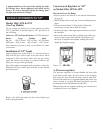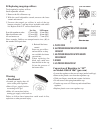Plastics
All plastics are vulnerable to heat, although some will
withstand higher temperatures than others. Keep all
plastics away from parts of the range which may become
slightly more than warm when the range is in operation.
Self-Cleaning Oven
The door gasket is essential for a good seal. Care should
be taken not to rub, damage or move the gasket.
Do not use oven cleaners on your oven prior to self-
cleaning. Damage may occur to oven finish at high
temperatures. Remove aluminum or plastic utensils, food or
combustible materials from oven and cooktop before self-
cleaning.
(See Self-Cleaning – Page 17)
NOTE: Oven cleaner will not harm porcelain oven but
should not be used in conjunction with self-cleaning.
Surface Cooking
Use proper pan size. Select pans large enough to cover the
element. The use of undersized pans will expose a portion
of the element which may result in burns, ignition of
clothing or spillovers directly on element.
Never leave surface units unattended at high heat setting.
Boil over or boil dry conditions could result in a fire.
Do not use glass or glazed ceramic cookware on the
surface burners, as sudden change in temperature may
break them.
Always turn off surface unit, before removing pots or
pans.
Turn handle of the pan toward the center of the cooktop,
without extending over nearby elements. This will reduce
the possibility of accidentally overturning the pan.
Let hot pans cool in a safe place, out of the reach of young
children. Never set hot pots on a combustible surface.
Do not use decorative metal covers on electric surface
elements. A covered element, when turned on, could result
in a burn or damage to the element.
Frying
Use as little oil as possible. Filling the pan too full of oil
can cause spillovers when food is added.
Foods for frying should be as dry as possible. Frost on
frozen foods or moisture on fresh foods can cause hot oil
to bubble up. Spillovers, fire and burns from splatters could
occur.
Use a deep fat thermometer whenever possible to prevent
overheating oil beyond smoking point.
Deep Fryer
Use extreme caution when moving a hot grease kettle or
disposing of hot grease.
Ventilating Hoods
Clean ventilation hood frequently — grease should not be
allowed to accumulate on hood or filter. When flaming
foods under the hood, turn the fan off. The fan, when
operating, may spread flame.
Service
Do not repair or service any part of the range unless
specifically recommended in this manual. All other
servicing should be referred to a qualified technician.
Disconnect the range from wall receptacle (or fuse) before
performing service.
Safety
Your range, like many other household items, is heavy
and can settle into soft floor coverings such as cushion
vinyl or carpeting. When moving the range on this type of
flooring use care.
If your range must stand beside a refrigerator, allow at
least 2” between the two appliances for air circulation.
The heat from the range may affect refrigerator
performance.
Make sure that all the packing materials, including tape
on elements and packing material above and below oven
elements, have been removed and that all controls are in
the off position before plugging in the power cord.
Electrical Connection
Maximum Amp. requirements BTU’s NAT BTU’s LP
Model 1850- 35 Amps, 240 Volts — —
1855- 50 Amps, 240 Volts — —
1860- 5 Amps, 120 Volts 59,000 53,100
1865- 30 Amps, 240 Volts 43,000 38,700
1867- 6 Amps, 120 Volts 79,000 71,100
1870- 30 Amps, 240 Volts 43,000 38,700
1875- 30 Amps, 240 Volts 63,000 56,700
All ranges come with standard range cord attached. This
cord must be plugged into a standard range receptacle
provided by your electrician.
Installation
Be sure your appliance is properly installed and grounded
by a qualified technician in accordance with the installation
instructions and local building codes.
Power cord installation
The new U.S. revised electrical code states that all new
construction must use a FOUR WIRE range power cord.
Existing construction may use a three wire range power
cord. NOTE: The difference is, a four wire cord has a
separate ground. A three wire cord is grounded through
the neutral.
To change from 3 wire to 4 wire cord:
• Makesureallpowerisshutoff.
• Removethebackpaneloftherangesothepowerblock
is visible.
• Unscrewterminalnutsandremovetherangecordwires
from the power block.
• Undogroundscrew attachingthewhite groundwire tothe
range body and remove wire.
• Undo the bushing holding cordtostove body and remove
cord from appliance.
Reassemble the new range cord kit to the range making sure
the white wire goes to the center of the terminal block, the
red to the right and the black wire to the left.
5



